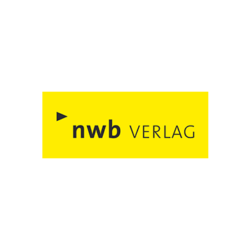NWB Verlag publishing house
When tax professionals and economic experts have questions, they get answers from the NWB Verlag publishing house in Herne, Germany, whether in a traditional book, on the website, or in an e-book, a PDF document or a print-on-demand book. Around 280 people from different educational and professional backgrounds work together in a family-like atmosphere at NWB Verlag, providing the right answers for their customers’ professional or educational needs. And all that while continuously improving their sustainability. NWB Verlag has existed since 1947, when the company started as a magazine publisher. Over the years, the publishing house has grown with the demands of its customers. To continue inspiring its customers with content that is both topical and practical, the publishing house has turned increasingly to digital tools. The heart of the publishing house’s digital offering is its online database, which offers the latest news, tools, legal decisions and much more that is important for its users’ daily work. But the products are not the only thing that the publisher is increasingly digitizing; it is also gradually mapping its internal processes in the digital world.
We looked each other in the eye and said, yes! That fits. And that was the start of a fabulous new relationship.
Andrea Weigert
Project Manager
NWB Verlag
Accelerating processes for textbook production
Designing and writing a textbook is a complex process. With each title, authors and publishers have to generate, collect and check a lot of new information. This information also has to be woven into a whole that is more than the sum of its parts. On the creative side, this means ensuring that there is a common thematic thread, and on the publishing side, it means implementing a standardized and digitized process. With the help of software manufacturer d.velop AG, NWB Verlag in Herne has created a new digital process for the production of textbooks. The new software solution is named “BooX,” and it not only accelerates processes—and thus production—but it also ensures transparency in the process, thereby increasing acceptance among the employees involved. With BooX, all information about the book and the process can now be found digitally in a single place and with the shortest possible access times.
The d.velop solution at a glance
Task: to digitize the process for producing a print book. All processes and work steps involved in the creation of a print book needed to be mapped in digital form. Up to 120 documents were to be stored, archived and versioned per book—and up to 280 times per year. The solution also had to increase production speed and provide transparency.
- Digitize paper workflows
- Make information centrally accessible
- Provide fast access to information
- Increase production speed
Project objectives: With the new software, NWB Verlag sought to digitize all production steps in the production of a new book, starting from the idea to write the book, through the editing, production, marketing and distribution of the book. Around 180 people are involved in such a process, all of whom must be incorporated into the solution.
Procedure: The key task in the procedure was to analyze and visualize all the relevant manual workflows in the publishing house. During this research and analysis phase, the partners had to make initial decisions about how a software for digitally implementing these workflows would look. The publishing house put together a process team that formulated requirements for the software during the planning phase. The partners followed the Scrum method to ensure agile development.
Result: The new software is called BooX and has been in use in all departments at NWB Verlag since mid-July 2018. BooX increases the transparency of the entire process: all departments can see which steps were taken before or after their own step in the process, which increases acceptance as employees are able to see outside their own “box.” The software also saves time, for example through faster access times to documents and records.
First step: analysis of all manual workflows
In order to digitize the internal processes, a team analyzed and visualized all the manual workflows in the publishing house. During this phase, the publishing house had to make initial decisions about how software for digitally implementing these processes would look. The print book process was selected as the first process to be implemented digitally. The publishing house put together a project team for this purpose. One employee from each department that would later work with the software was included in the team. According to Andrea Weigert, Project Manager for Project and Process Management (PPM) at NWB Verlag, the focus of the discussions was on the question, “Where can we store documents, such as dockets, so that they are accessible to everyone and are stored centrally (across all departments) in their latest version?”
- Documents accessible to everyone
- Documents stored centrally in their most up-to-date version
- Digital process implemented in a web application
- Entire print book process mapped
The project team formulated further software requirements during the planning phase. For example, the entire process needed to be implemented in a common web application (SharePoint). In addition to centralized document storage, they also needed the ability to assign tasks. Another request by the project team: to map the entire print book process with the software and show each user the current status of the various cases within the process.
d.velop as partner
The company’s future partner would have to meet all the requirements of the project team. After a standardized selection procedure and several interviews, the publishing house chose d.velop as its partner. “We looked each other in the eye and said, yes! That fits. And that was the start of a fabulous new relationship,” says NWB project manager Andrea Weigert in describing the partnership. The project started in July 2017 with the aim of going live in mid-2018. The project team had already decided on a name for the software: BooX. Andrea Weigert quickly explained how they came up with the name: “BooX—the Boo stands for book, and the X stands for so much more.”
Procedure
The team realized the project in five phases, which are called “sprints” according to Scrum. Through this agile approach the team learned quite a lot, both on d.velop’s end—concerning the customers’ exact requirements and wishes—and on the part of NWB. Andrea Weigert praises the agile approach: “At every step we became a little more aware of what we actually wanted.” Over the course of the project, the software took on an increasingly concrete form.
The project team tested the BooX software after each sprint, using three different types of books as examples. This allowed the team to bring new requirements or changes to Markus Gevers over the course of the project so that they could be implemented together in an agile manner. This approach allowed key changes to be incorporated into the software while development was ongoing. The result demonstrates one of Scrum’s greatest strengths: the ability to develop complex software step by step while adhering closely to customer requirements.
Progress of the project
Although the start of a project always feels a bit magical, sometimes you need to find the right project manager first. The d.velop project manager had to fit the corporate culture of the client, as this is decisive for the success of the project. The chemistry between client and project manager has to be just right. And if it doesn’t work out the first time, d.velop can fall back on a pool of highly qualified project managers with a wealth of professional expertise.
Experience has shown that there is always someone who fits the particular corporate culture. According to Andrea Weigert: “Markus Gevers was the right project manager for us. He speaks our language perfectly and we got along well from the start.” At the beginning of the project, both sides decided on an agile approach to the BooX project. The in-house development department at NWB Verlag already works with Scrum, and the project manager on the NWB side was even a Scrum Master. The persons involved on d.velop’s end had also been trained in Scrum. Scrum is a project management approach that favors intermediate results over a long and possibly wasteful planning phase before the start of the project .
What does the new software do?
The BooX software solution, which d.velop AG developed together with NWB Verlag, digitally maps the entire process and all work steps in the creation of a print book, starting from the idea to write the book, through the editing, production, marketing and distribution of the book. Around 180 people are involved in such a process. Up to 120 documents are stored, archived and versioned per book—and up to 280 times a year. Thanks to the d.velop AG solution, all information about the product and the process can always be found quickly and in a single place. The information is structured by subdividing it into main processes and process steps. This allows every user to quickly see what needs to be edited where and in which context.
- Shorter access times
- Traceable and transparent work steps
- High acceptance through transparency
- Mapping of the entire process
Overall, we are very satisfied with the partnership. The communication and planning were great.
Andrea Weigert
Project Manager
NWB Verlag
Project goals & results: fast access to documents, transparent processes, higher productivity
BooX has been live since mid-July 2018 and is in use by all departments at NWB Verlag. The software increases the transparency of the entire process, allowing all departments to see which steps were taken before or after their own step in the process. Andrea Weigert credits this ability to look outside one’s own “box” with increasing acceptance among the different departments, which would otherwise have hardly any points of contact. The time savings achieved by the digital process are also already being seen. NWB Verlag has already started over 100 books in BooX, explains Andrea Weigert. By the end of 2018 at the latest—about half a year after the start of the project—the first book to be entirely processed in BooX should be published. The previous process for creating a book took between three months and a year, from the idea to the moment it was in the hands of a reader. “Overall, we are very satisfied with the partnership. The communication, the planning and the implementation on the part of d.velop were great. They kept all their promises, and even if there were a few small things along the way, the project was very successful. The entire project was completed on schedule,” says Andrea Weigert.

